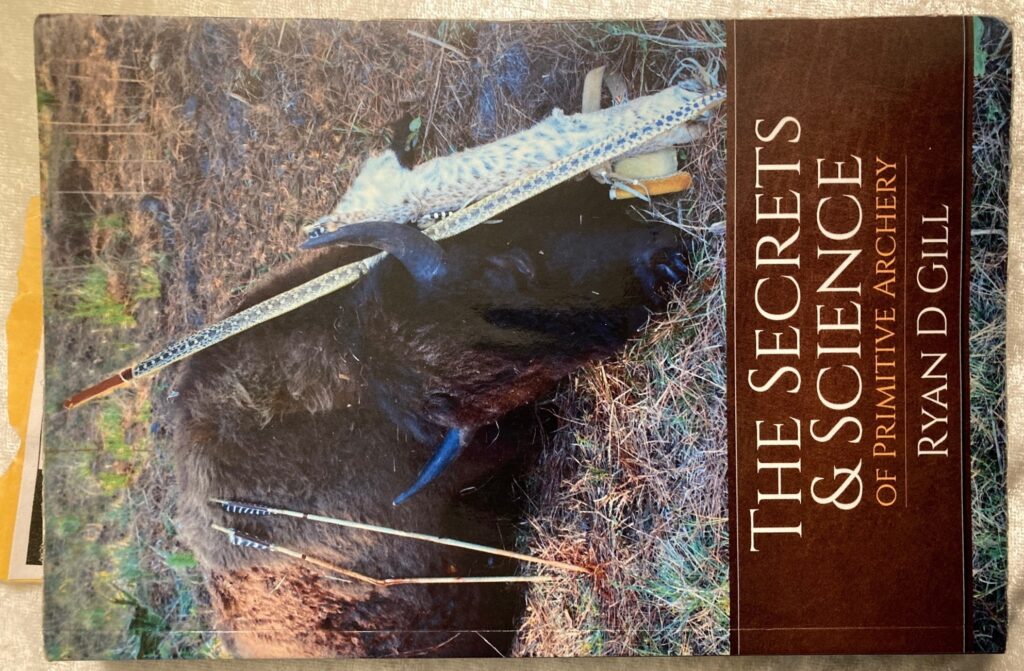Archive → January, 2024
Book review: Secrets & Science of Primitive Archery
Ryan Gill’s book, The Secrets & Science of Primitive Archery, is a must-have for all stick bow hunters. You cannot find your way in the dark without a light, and this book is the illumination every traditional and self-bow hunter needs. I don’t care how long you have been hunting with your Osage orange self-bow or even a traditional bow by a small maker. If you hunt with something that does not have training wheels, then you need this book.
I must admit that I am almost ashamed it has taken me over a YEAR to review this book. Actually almost two years. Author Ryan Gill deserves much better treatment for all the hard work he put into this book. What can I say, Ryan. America has had a lot of ups and downs since 2021, and for political watchers and commenters like me, practically every day has felt like an all-hands-on-deck. All the political stuff has taken up the blog space. I am sorry, buddy. Hopefully I finally give you and the excellent book your due here.
As a traditional archery hunter since I was about fourteen, I have been enamored of bows made of a simple stick and a string. When us kids made our own bows out of saplings we cut in our woods (fifty years ago…), we would tie on a piece of baling twine and shoot arrows made of tree branches, goldenrod, whatever we could get our hands on, and practice with what we had. As the years went past, some of us were gifted compound bows, and others got simple recurves. I got a recurve, and some pretty sorry secondhand Easton aluminum arrows, to which I attached basic Bear broadheads.
If I had a nickel for every deer I collected hair from, I would have enough to buy a malted milkshake at the Lewisburg Freeze, which was fifty cents way back when, and costs five bucks now. That is to say, I never killed a deer with a bow, but missing didn’t stop me from trying.
Fast forward and I had my own kids, all of whom enjoyed shooting little fiberglass kid bows. When the boy attained the age of about seven, he demanded a “real bow,” and so off to the Eastern Traditional Archery Rendezvous we went. There we located a nice faux curly maple kid recurve with about 20 pounds of pull. Enough to skewer a squirrel or ball up a bunny in the back yard, which the boy kept after. Many years later we would go back to ETAR to get his real Big Boy bow, a reflex-deflex by the Kilted Bowyer. At 43 pounds pull weight at 26 inches, this is a true hunting machine, pretty, yes, but in all the clean simplicity a true bow should have.
But in between the little boy bows and the last big boy bow there were a lot of experiments over the years. Saplings cut, strings attached, arrows made, trials run. Like I did when I was a kid fascinated with the basic but powerful physics of archery. And this is where Ryan Gill’s fascinating book enters the picture.
Ryan Gill came to our attention by his YouTube videos. Because we were naturally looking for information about what we were doing right and doing wrong. Ryan doesn’t just cut saplings, attach a string, and shoot some crappy home made arrows. Au contraire! Ryan makes all kinds of powerful self-bows from all kinds of different woods, including Osage orange, hickory, black locust, and others, that will kill deer, bear, wild hogs, and even huge bison. And then Ryan strings the bows with real animal gut. And then he makes real cane arrows, tipped with real flint and chert heads that he himself knapped. Talking the real deal here. And through it all in his videos and his book, Ryan explains how primitive archery really worked tens of thousands of years ago, and how it can work really well for us today.
I learned a lot from this book.
Because I am a numbers guy, Ryan’s statistical analysis of his different bows, using different strings (animal and plant fiber), using different arrow shafts (river cane, wood) etc, really speaks to me. He does a great job of tabulating his data, which, when all his testing is said and done, tells us exactly where to go: Osage orange bow stave that is dried daily, using either a modern bow string or an animal gut string, and shooting properly made river cane shafts fletched with goose feathers and tipped with the proper and surprisingly small stone arrowhead, that go at least 130 feet per second, with 150 fps or better being the best and most likely to catch an unaware deer standing flat-footed.
If you are at all a traditional or aspiring primitive archery person, you need this book. This is a must-have resource that you will find nowhere else. It has an incredible amount of fascinating and directly applicable how-to information to every step and facet of primitive and traditional archery, as well as the historic and anthropological background to how primitive archery evolved. I read it twice before I felt qualified to write about it here, and I highly recommend it.
